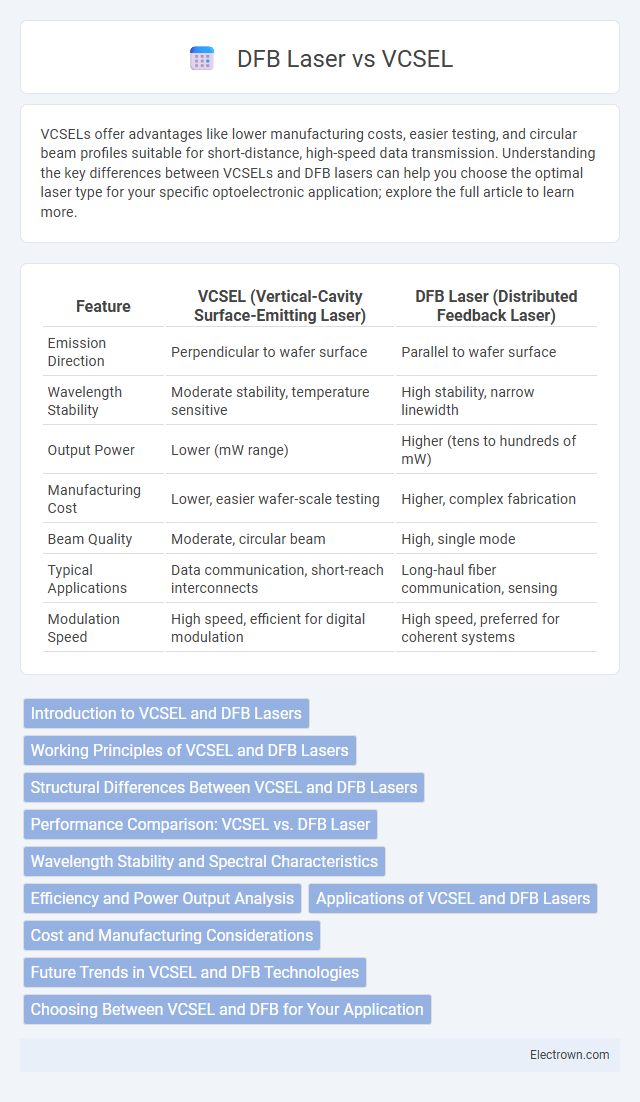VCSELs offer advantages like lower manufacturing costs, easier testing, and circular beam profiles suitable for short-distance, high-speed data transmission. Understanding the key differences between VCSELs and DFB lasers can help you choose the optimal laser type for your specific optoelectronic application; explore the full article to learn more.
Table of Comparison
| Feature | VCSEL (Vertical-Cavity Surface-Emitting Laser) | DFB Laser (Distributed Feedback Laser) |
|---|---|---|
| Emission Direction | Perpendicular to wafer surface | Parallel to wafer surface |
| Wavelength Stability | Moderate stability, temperature sensitive | High stability, narrow linewidth |
| Output Power | Lower (mW range) | Higher (tens to hundreds of mW) |
| Manufacturing Cost | Lower, easier wafer-scale testing | Higher, complex fabrication |
| Beam Quality | Moderate, circular beam | High, single mode |
| Typical Applications | Data communication, short-reach interconnects | Long-haul fiber communication, sensing |
| Modulation Speed | High speed, efficient for digital modulation | High speed, preferred for coherent systems |
Introduction to VCSEL and DFB Lasers
VCSELs (Vertical-Cavity Surface-Emitting Lasers) emit light perpendicular to the wafer surface, enabling efficient on-wafer testing and low-cost high-density arrays, making them ideal for data communication and sensing applications. DFB (Distributed Feedback) lasers produce single-wavelength emission through an integrated grating structure, offering narrow linewidth and high spectral purity crucial for coherent communication and high-precision sensing. Both VCSELs and DFB lasers leverage semiconductor technology but differ significantly in emission geometry and spectral properties, tailoring their use in optical networks and sensing systems.
Working Principles of VCSEL and DFB Lasers
VCSELs (Vertical-Cavity Surface-Emitting Lasers) emit light perpendicular to the wafer surface using a vertical resonant cavity formed by distributed Bragg reflectors, enabling efficient single-mode emission and easy beam shaping. DFB (Distributed Feedback) lasers operate by integrating a periodic grating structure along the waveguide, providing wavelength-selective feedback for stable single-frequency lasing through distributed Bragg reflection. The working principle distinction rests on VCSELs' vertical emission with a short cavity and DFB lasers' edge emission with a longitudinal grating for precise wavelength control.
Structural Differences Between VCSEL and DFB Lasers
VCSELs (Vertical-Cavity Surface-Emitting Lasers) feature a vertical cavity structure with mirrors formed by distributed Bragg reflectors (DBRs) perpendicular to the wafer surface, allowing emission vertically, whereas DFB lasers (Distributed Feedback Lasers) have an edge-emitting horizontal cavity incorporating a periodic grating for wavelength stabilization along the waveguide. The VCSEL's thin active region lies between high-reflectivity DBR mirrors, resulting in a short cavity length and circular beam output, while the DFB laser uses a longer cavity with an integrated diffraction grating to provide single-mode operation. These structural differences impact mode control, fabrication complexity, and beam profile, with VCSELs offering easier wafer-scale testing and DFB lasers offering narrow linewidth for telecom applications.
Performance Comparison: VCSEL vs. DFB Laser
VCSELs offer superior energy efficiency and lower threshold currents compared to DFB lasers, making them ideal for short-reach optical communication and sensing applications. DFB lasers provide higher output power and narrower linewidths, enabling better performance in long-haul fiber optic transmissions and high-speed data networks. The choice between VCSEL and DFB lasers depends on specific application requirements such as modulation speed, spectral purity, and integration density.
Wavelength Stability and Spectral Characteristics
VCSELs offer superior wavelength stability at varying temperatures due to their surface emission and symmetric cavity design, ensuring consistent spectral output. DFB lasers provide narrower linewidths and highly stable single-mode operation, ideal for applications requiring precise spectral characteristics. Your choice depends on whether wavelength stability or spectral purity is the primary requirement for your optical system.
Efficiency and Power Output Analysis
VCSELs exhibit higher wall-plug efficiency due to their vertical emission and reduced threshold current, making them ideal for low-power applications. DFB lasers deliver superior power output and narrow linewidth, essential for high-speed optical communication systems requiring stable single-mode operation. Efficiency in VCSELs typically ranges around 40-60%, while DFB lasers prioritize output power up to several tens of milliwatts with efficiencies often lower than VCSELs.
Applications of VCSEL and DFB Lasers
VCSELs (Vertical-Cavity Surface-Emitting Lasers) are commonly used in high-speed data communication, 3D sensing, and facial recognition due to their low power consumption and efficient surface emission. DFB (Distributed Feedback) lasers are preferred in long-haul fiber optic communication and precise spectroscopy applications because of their narrow linewidth and stable single-mode output. Your choice between VCSEL and DFB lasers depends on the required wavelength stability and power efficiency for the specific optical system.
Cost and Manufacturing Considerations
VCSELs offer lower manufacturing costs due to wafer-level testing and simpler packaging compared to DFB lasers, which require more complex fabrication and individual testing. Your choice impacts total system expenses, with VCSELs favored for high-volume, cost-sensitive applications while DFB lasers remain suitable for high-precision, narrow-linewidth needs despite higher costs. Understanding production scalability and yield differences helps optimize budget allocation in photonics projects.
Future Trends in VCSEL and DFB Technologies
Future trends in VCSEL technology emphasize higher modulation speeds and energy efficiency for data communication and sensing applications, driven by advances in nano-fabrication and integration with silicon photonics. DFB lasers are evolving with enhanced wavelength stability and narrow linewidths, optimized for coherent optical communication and high-precision sensing systems. Both VCSEL and DFB developments focus on expanding bandwidth capabilities and cost-effective manufacturing to meet the demands of 5G, LiDAR, and emerging quantum photonics markets.
Choosing Between VCSEL and DFB for Your Application
VCSELs offer advantages in cost efficiency, low power consumption, and ease of testing, making them ideal for short-reach data communication and sensing applications. DFB lasers provide higher spectral purity and stability, suited for long-haul telecommunications and precise wavelength requirements in dense wavelength division multiplexing (DWDM). Selection depends on specific needs for output power, spectral linewidth, temperature stability, and integration complexity to match application demands.
VCSEL vs DFB laser Infographic

 electrown.com
electrown.com